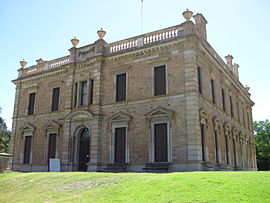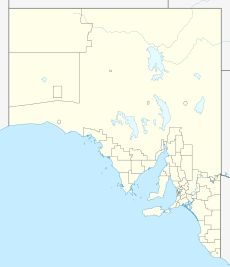Mintaro
|
Mintaro South Australia |
|||||||||||||||
|---|---|---|---|---|---|---|---|---|---|---|---|---|---|---|---|

Martindale Hall
|
|||||||||||||||
| Coordinates | 33°55′01″S 138°43′15″E / 33.91694°S 138.72083°ECoordinates: 33°55′01″S 138°43′15″E / 33.91694°S 138.72083°E | ||||||||||||||
| Population | 188 (2016 census) | ||||||||||||||
| Established | 1849 | ||||||||||||||
| Postcode(s) | 5415 | ||||||||||||||
| Location | |||||||||||||||
| LGA(s) | District Council of Clare and Gilbert Valleys | ||||||||||||||
| Region | Mid North | ||||||||||||||
| State electorate(s) | Frome | ||||||||||||||
| Federal Division(s) | Wakefield | ||||||||||||||
|
|||||||||||||||
| Footnotes | |||||||||||||||
Mintaro is a historic town in the eastern Clare Valley, east of the Horrocks Highway, about 126 kilometres (78 miles) north of Adelaide, South Australia. The town lies at the south-eastern corner of the Hundred of Clare, within the Clare Valley wine region. Established in 1849, Mintaro is situated on land which was bought originally by Joseph and Henry Gilbert, which they sub-divided into 80 allotments. Mintaro was originally intended as a stopping and resting place for the bullock teams (muleteers) carting copper ore from the Burra mine to Port Wakefield. By 1876 the population was recorded as 400. Mintaro continued to develop as a rural service centre during the 1870s and early 1880s, when pastoral and agricultural activities boomed in the state's mid north.
The Mintaro district includes prominent Martindale Hall and Kadlunga, two large pastoral properties. Known for its high quality, Mintaro slate is produced from what is believed to be the oldest continuing operating quarry in Australia. Although Mintaro is primarily an agricultural community, tourism plays an increasingly important role. Due to its historical and cultural significance, the entire town of Mintaro was declared a State Heritage Area for South Australia in 1984.
The Mintaro district was explored by Europeans in mid-1839, first by John Hill, and then by Edward John Eyre. The area north of Gawler was officially opened by a series of special surveys in the early 1840s. Land in the Barossa and Clare Valleys was quickly taken up. The first settler in Mintaro was pastoralist James Stein who from 1841 held occupation licences for extensive sheep runs stretching from Mount Horrocks through Farrell Flat to the Burra district. Stein subsequently established his homestead on a tributary of the Wakefield River, in a valley beneath Mount Horrocks, about three kilometres west of present Mintaro.
...
Wikipedia

